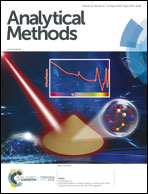基于微流控纸质分析装置的用于检测癌胚抗原的双模式均相电化学比色生物传感传感器
IF 2.7
3区 化学
Q2 CHEMISTRY, ANALYTICAL
引用次数: 0
摘要
与单反应系统相比,基于双模式的传感器具有更高的准确性和灵敏度,因此引起了广泛的关注。为了准确灵敏地检测癌胚抗原(CEA),我们开发了一种基于酶联免疫吸附试验(ELISA)的简单电化学和比色双模传感器,无需对电极表面进行复杂的修饰。目标 CEA 被与辣根过氧化物酶(HRP)偶联的抗体识别,然后 HRP 氧化底物 3,3',5,5'-四甲基联苯胺(TMB),产生比色和电化学信号。我们创建了一个带有双模均质传感微流控的纸基分析装置(μPAD),其中三个纸基检测区用于比色检测,一个双电极嵌入式检测区用于电化学检测。采用比色分析技术时,CEA 检测的线性范围为 0.6-40 ng/mL,检出限(LOD)为 0.2 ng/mL。采用电化学分析技术,线性范围为 0.1-40 纳克/毫升,检测限为 0.03 纳克/毫升。比色法的可视性和直观性为电化学方法的高灵敏度和快速反应提供了参考。还开发了智能手机应用程序(APP),以实现比色信号的双重提取。基于 ELISA 的比色检测系统为电化学传感的发展提供了一条新的途径,使其具有内在的自我验证和自我校正功能,有望提供更可靠、更准确的检测结果。本文章由计算机程序翻译,如有差异,请以英文原文为准。
A dual-mode of homogeneous electrochemical-colorimetric biosensing sensor for carcinoembryonic antigen detection based on microfluidic paper-based analysis device
Dual-mode based sensors have drawn a lot of interest due to their high accuracy and sensitivity compared to single-response systems. A simple electrochemical and colorimetric dual-mode sensor based on enzyme-linked immunosorbent assay (ELISA), without complex electrode surface modification, was developed for accurate and sensitive detection of carcinoembryonic antigen (CEA). A target CEA is recognized by an antibody coupled to horseradish peroxidase (HRP), which then oxidizes the substrate 3,3',5,5'-tetramethylbenzidine (TMB) to generate both a colorimetric and an electrochemical signal. A paper-based analysis device (μPAD) with dual-mode homogeneous sensing microfluidic was created, three paper-based detection areas for colorimetric testing, and a two-electrode embedded detection area for electrochemical testing. When applying colorimetric analysis technology, the linear range of CEA detection is 0.6–40 ng/mL, and the limit of detection (LOD) is 0.2 ng/mL. The linear range is 0.1-40 ng/mL and the LOD is 0.03 ng/mL by applying electrochemical analysis. The visibility and intuitiveness of colorimetry provide a reference for higher sensitivity and quick response of the electrochemical method. a smartphone application(APP) was also developed to realize the dual extraction of colorimetric signals. The colorimetric detection system based on ELISA can provide a new path for the development of electrochemical sensing and makes it have inherent self-verification and self-correction functions and is expected to provide more reliable and accurate detection results.
求助全文
通过发布文献求助,成功后即可免费获取论文全文。
去求助
来源期刊

Analytical Methods
CHEMISTRY, ANALYTICAL-FOOD SCIENCE & TECHNOLOGY
CiteScore
5.10
自引率
3.20%
发文量
569
审稿时长
1.8 months
期刊介绍:
Early applied demonstrations of new analytical methods with clear societal impact
 求助内容:
求助内容: 应助结果提醒方式:
应助结果提醒方式:


